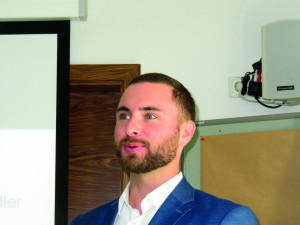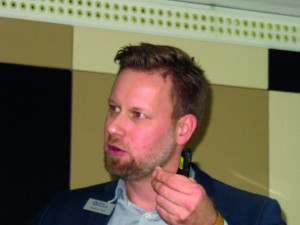At the Test Convention 2022, Göpel electronic GmbH, Jena, provided information about its entire portfolio and presented a new technology for universal in-system programming and embedded testing as well as a new fast path to the AOI program.
Successful under extreme conditions
 André WiersigThetwo-day event with presentations and workshops started with the keynote speech 'Successful under extreme conditions'. André Wiersig used his biography to explain how this is achieved. He was the first person from a German-speaking country to successfully complete the Ocean's Seven Mission, i.e. to swim through seven straits around the world, including the English Channel. By way of introduction, he said: "I love the sea". He talked about how he prepared for it and what the particular challenges were in each case. The rules are strict. You are not allowed to wear a wetsuit or other protection against the cold while swimming and you are not allowed to touch the accompanying boat. The sea water is cold and, as he said, you never get used to it despite regular ice water baths. You need to be well informed in advance about the potential risks, such as sharks and jellyfish, and prepare accordingly. His motto is: "Just do it." Because: "Everything impossible remains impossible if you don't try."
André WiersigThetwo-day event with presentations and workshops started with the keynote speech 'Successful under extreme conditions'. André Wiersig used his biography to explain how this is achieved. He was the first person from a German-speaking country to successfully complete the Ocean's Seven Mission, i.e. to swim through seven straits around the world, including the English Channel. By way of introduction, he said: "I love the sea". He talked about how he prepared for it and what the particular challenges were in each case. The rules are strict. You are not allowed to wear a wetsuit or other protection against the cold while swimming and you are not allowed to touch the accompanying boat. The sea water is cold and, as he said, you never get used to it despite regular ice water baths. You need to be well informed in advance about the potential risks, such as sharks and jellyfish, and prepare accordingly. His motto is: "Just do it." Because: "Everything impossible remains impossible if you don't try."
Comprehensive automotive test solutions
In the first technical presentation, Markus Koppetsch, Göpel electronic GmbH, provided information about the automotive test solutions offered by Göpel electronic - test technology for the automotive industry and its suppliers - based on the requirements. This portfolio covers everything - electronics and mechatronics, including applications with electric drives - and ranges from standard products to customer-specific solutions. The former include, for example, multibus controllers, the Net2Run solution for signal-based residual bus simulation of heterogeneous vehicle networks and the Dragon Suite for capturing and generating video data for testing display and/or camera systems with an LVDS interface. End-of-line test systems are also offered, including fully automated test cells for integration into production lines. These include engine, seat and network testers as well as systems for acoustic analysis and haptic testing. Göpel electronic's customer-specific engineering solutions range from the concept to the final system solution.
 Markus KoppetschAftera coffee break, the other presentations took place in two parallel sessions on the two subject areas of embedded JTAG solutions and inspection solutions (AOI, AXI, SPI, IBV). The following selection mainly comprises innovations.
Markus KoppetschAftera coffee break, the other presentations took place in two parallel sessions on the two subject areas of embedded JTAG solutions and inspection solutions (AOI, AXI, SPI, IBV). The following selection mainly comprises innovations.
X-BUS - a new technology
With X-BUS, Göpel electronic has developed a new technology for the universal emulation of serial bus interfaces for use in electronics development and production. Thomas Wenzel, Göpel electronic GmbH, explained what the direct line to the interface: X-BUS makes possible. As part of the Cascon software system, X-BUS enables a purely software-supported definition of bus protocols. This means that less hardware is required for embedded testing and in-system programming. Modern test and programming systems are constantly faced with the challenge of controlling a wide variety of bus interfaces (e.g. serial bus interfaces such as SPI, I²C, JTAG or SWD). These buses can also exist in a wide variety of expansion stages and modes. Test and programming systems must have hardware control units (controllers) for bus communication. The type and number of controllers depend on the connected test objects. X-BUS addresses this problem and enables flexible control of a wide variety of bus interfaces based on a single control unit. The X-BUS technology uses a universal protocol script (ASCII) in combination with special SFX II/SCB II hardware functions and pre-compiled IP (option). This enables highly dynamic switching between various bus protocols without time-consuming re-initialization or hardware reconfigurations. Thomas Wenzel used examples to illustrate the advantages of the new X-BUS technology. Among other things, it offers a significant increase in speed up to maximum throughput, e.g. for serial flash programming.
Example of system integration
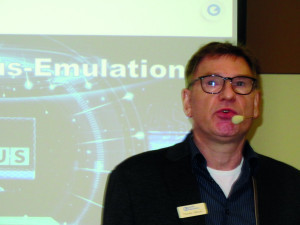 Thomas WenzelMarcSchmuck, Seica Deutschland GmbH, Ettlingen, presented his company and gave an overview of its products, highlighting their special features. For example, the flying probe test systems are characterized by their vertical PCB transport, which prevents the PCBs from bending and is particularly advantageous for flexible PCBs. He then used a practical example to explain how the BS system integration is implemented in Seica Compact ICT. In a multi-stage selection process, Zollner Elektronik AG determined the system that performs the in-circuit test (ICT) according to its current requirements. This also included the continued use of the existing Teradyne Spectrum adapters. Seica's Compact Digital Next>Series is an appropriate test system with capabilities that go beyond a simple logic analyzer. It is designed for testing integrated components using vector-based techniques and special protocols such as boundary-scan. Its 54 slots make (XL version) up to 2048 analog channels or 2048 hybrid channels available. Thanks to the IFR/Aeroflex interfaces, the existing adapters at Zollner can be used with the Seica Vacuum Fixture CD XL 4JOB. Marc Schmuck went into detail about the CD XL 4JOB system resources and the VIVA Multijob. The Compact Digital Next>Series can also be operated fully automatically as an inline system together with a robot/cobot.
Thomas WenzelMarcSchmuck, Seica Deutschland GmbH, Ettlingen, presented his company and gave an overview of its products, highlighting their special features. For example, the flying probe test systems are characterized by their vertical PCB transport, which prevents the PCBs from bending and is particularly advantageous for flexible PCBs. He then used a practical example to explain how the BS system integration is implemented in Seica Compact ICT. In a multi-stage selection process, Zollner Elektronik AG determined the system that performs the in-circuit test (ICT) according to its current requirements. This also included the continued use of the existing Teradyne Spectrum adapters. Seica's Compact Digital Next>Series is an appropriate test system with capabilities that go beyond a simple logic analyzer. It is designed for testing integrated components using vector-based techniques and special protocols such as boundary-scan. Its 54 slots make (XL version) up to 2048 analog channels or 2048 hybrid channels available. Thanks to the IFR/Aeroflex interfaces, the existing adapters at Zollner can be used with the Seica Vacuum Fixture CD XL 4JOB. Marc Schmuck went into detail about the CD XL 4JOB system resources and the VIVA Multijob. The Compact Digital Next>Series can also be operated fully automatically as an inline system together with a robot/cobot.
THT production concepts with AOI
After the lunch break, Jens Kokott,-Göpel electronic GmbH, and Christopher Scherf, haprotec GmbH, Kreuzwertheim, demonstrated that many paths lead to the same goal by presenting examples of possible THT production concepts with AOI and bad-board handling. Beforehand, they provided information about their corresponding products and solutions. Jens Kokott presented the world's first 3D measuring module for the THT soldering and component side, which can also be used to check the component height (correct assembly, coplanarity) as well as the solder volume and pin length. The advantages and disadvantages of different line configurations were described. Verification with repair at the respective placement location is advantageous because it is carried out by the placement personnel and the component defects can be repaired 'cold' 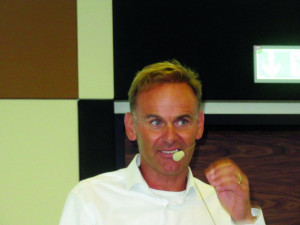 Marc Schmuckwerden. In addition, less space is required in the line. Increased throughput through immediate verification of the placement after AOI is possible by means of direct ejection and lift for return transport. For placement stations with integrated AOI (component inspection directly at the placement station) as well as verification and repair, a further increase in throughput is possible thanks to immediate verification. An alternative to this is decentralized solder joint verification. Production-specific integration enables significant savings in terms of personnel and space requirements as well as cycle time. Early involvement of the AOI supplier and the line integrator is advisable for optimization.
Marc Schmuckwerden. In addition, less space is required in the line. Increased throughput through immediate verification of the placement after AOI is possible by means of direct ejection and lift for return transport. For placement stations with integrated AOI (component inspection directly at the placement station) as well as verification and repair, a further increase in throughput is possible thanks to immediate verification. An alternative to this is decentralized solder joint verification. Production-specific integration enables significant savings in terms of personnel and space requirements as well as cycle time. Early involvement of the AOI supplier and the line integrator is advisable for optimization.
Digitalization in the electronics industry
Jeremy Schitter, Siemens AG, Strasbourg, France, spoke about digitalization in the electronics industry: twins with potential. The equipment used in electronics production can now communicate. Nevertheless, many companies still have silos of systems and processes with manual workflows. The market is increasingly demanding smart manufacturing for process management and production systems. Digital Enterprise is the comprehensive digital twin approach for the continuous optimization of product and production in a data-driven industry. This enables realistic simulations and the validation of products, machines, production lines and complete systems. The digital twin approach also serves as the basis for flexible and efficient production. With digital twins for the company, products, processes and production, batch size 1 can be realized, among other things. The integration of product and process design enables manufacturability tests to be carried out at an early stage in order to bring a product to market in the shortest possible time.
Fast routes to the AOI program
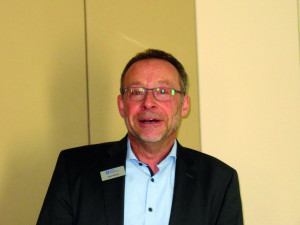 Jens KokottJensKokott explored the question of how to get to the AOI program quickly. With a sample assembly or digital twin? He described how to create an AOI test program with a real assembly and MagicClick and how this can be done with a digital twin. MagicClick requires a 3D AOI system in addition to a defect-free assembly and production data. The latter is required to determine the necessary height information that is not otherwise available. The digital twin requires information on the housing and pin type, component and pin dimensions, polarity feature and position, solder joint shape, color, surface and material in coordinated data formats for the digital description in order to make an optimized test program available before the first assembly is produced. The Data Prep Express tool from Siemens is used for the component information. Jens Kokott showed how Data Prep Express is used to transfer data from the component library and access an online library via the manufacturer part number. The subsequent data preparation for the test program creation is also carried out here with MagicClick. The optimization of the inspection program with AOI measured values from production is the second stage in development and, according to his outlook, this will take place in a third stage using simulated solder joints.
Jens KokottJensKokott explored the question of how to get to the AOI program quickly. With a sample assembly or digital twin? He described how to create an AOI test program with a real assembly and MagicClick and how this can be done with a digital twin. MagicClick requires a 3D AOI system in addition to a defect-free assembly and production data. The latter is required to determine the necessary height information that is not otherwise available. The digital twin requires information on the housing and pin type, component and pin dimensions, polarity feature and position, solder joint shape, color, surface and material in coordinated data formats for the digital description in order to make an optimized test program available before the first assembly is produced. The Data Prep Express tool from Siemens is used for the component information. Jens Kokott showed how Data Prep Express is used to transfer data from the component library and access an online library via the manufacturer part number. The subsequent data preparation for the test program creation is also carried out here with MagicClick. The optimization of the inspection program with AOI measured values from production is the second stage in development and, according to his outlook, this will take place in a third stage using simulated solder joints.
X-ray inspection for beginners
In the last presentation, Andreas Türk, Göpel electronic GmbH, provided compact knowledge for getting started in the world of X-ray inspection. He provided detailed answers to frequently asked questions such as:
- Why is X-ray inspection needed?
- Manual or automatic X-ray system?
- Requirements for operating an X-ray system?
- Risks for operators and components?
- What defects are detected with AXI systems?
- How long does it take to create an inspection program?
Andreas Türk explained, among other things, how X-ray works physically and how it can be used to inspect hidden solder joints. He also illustrated this with practical examples.


